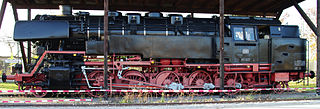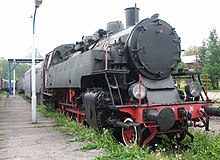
The DB Class 66 was a class of two Deutsche Bundesbahn (DB) locomotives designed for fast goods train and passenger train services on the main and branch lines of Deutsche Bundesbahn (DB), the national railway of the former West Germany.

The Prussian Class P 8 of the Prussian state railways was a 4-6-0 steam locomotive built from 1906 to 1923 by the Berliner Maschinenbau and twelve other German factories. The design was created by Robert Garbe. It was intended as a successor to the Prussian P 6, which was regarded as unsatisfactory.

The two-cylinder, superheated Bavarian Pt 2/3 engine was built by Krauss for the Royal Bavarian State Railways between 1909 and 1915. With its characteristic design - a carrying axle placed well to the front and two coupled axles at the rear under the outer firebox they asserted themselves over the rival Bavarian Pt 2/4 N and H classes and, after the demand fell for the services for which they were originally designed, they continued to be operated well into the 1960s on south German branch lines.

The Deutsche Reichsbahn had a standard passenger train tank engine with a wheel arrangement of 1′C1′ or 2-6-2 and a low axle load, which was designated in their classification system as the DRG Class 64. The Class 64 was developed from 1926 onwards and it was built between 1928 and 1940. Many German manufacturers contributed to the series.

The Bavarian Class R 3/3 of the Royal Bavarian State Railways was an 0-6-0T intended for goods trains. Of the engines delivered before World War I, one went to the Polish PKP, the other 17 were included by the Deutsche Reichsbahn as Class 89.7 in their numbering plan. The 90 units of the second series that were supplied from 1921 onwards all went into the Reichsbahn, and were designated as Class 89.8. 86 examples went into the Deutsche Bundesbahn after the Second World War and the last one was not taken out of service until 1960.

German Class 45 steam locomotives were standard locomotives (Einheitslokomotiven) designed by the Deutsche Reichsbahn for hauling goods trains.

The DRB Class 42 was a type of steam locomotive produced for the Deutsche Reichsbahn. It is one of the three main classes of the so-called war locomotives (Kriegslokomotiven), the other two being class 50 and 52.

The Class 44 was a ten-coupled, heavy goods train steam locomotive built for the Deutsche Reichsbahn as a standard steam engine class (Einheitsdampflokomotive). Its sub-class was G 56.20 and it had triple cylinders. It was intended for hauling goods trains of up to 1,200 tonnes on the routes through Germany's hilly regions (Mittelgebirge) and up to 600 tonnes on steep inclines. They were numbered 44 001-44 1989.

The Class 85 was a German goods train tank engine and standard locomotive (Einheitslok) with the Deutsche Reichsbahn.

The Class 62 engines were standard passenger train tank locomotives of Germany's Deutsche Reichsbahn-Gesellschaft (DRG).

The locomotives of the German DRG Class 81 were standard (Einheitsdampflokomotiven) goods train tank locomotives with the Deutsche Reichsbahn-Gesellschaft (DRG).

The DRG Class 89.0 was a goods train tank engine of standard design built for the Deutsche Reichsbahn (DRG).
The German DRG Class 71.0 was a 2-4-2T locomotive with the Deutsche Reichsbahn, which was intended as a replacement for railbuses. Originally it had been planned for these standard engines (Einheitsloks) to haul fast passenger trains.

Between 1934 and 1941 the Deutsche Reichsbahn (DRG) converted a total of 691 former Prussian-built Class 55.25–56 steam locomotives; the result was the DRG Class 56.2–8. The carrying axle enabled higher speeds and the engine could even be used as a passenger train locomotive. In addition the average axle load was lower, so that these locomotives could also be used on branch lines. The conversion entailed moving the boiler forward and raising it somewhat. The vehicles were given operating numbers between 56 201 and 56 891, although the numbering was not continuous.

The Württemberg Class K steam locomotives of the Royal Württemberg State Railways were the only twelve-coupled locomotives built for a German railway company.

The Prussian G 10 was a German goods train, steam locomotive, whose design was based on a combination of the running and valve gear from the Prussian T 16 and the boiler from the Prussian P 8. In developing the G 10, however, the T 16 running gear with side play on the first and fifth axles was modified. The T 16 was also subsequently built with this modified configuration and called the Prussian T 16.1. The G 10 was intended for heavy goods train duties on main lines, but as a result of its low axle load it could be employed more flexibly than its equally powerful cousin, the Prussian G 8.1. The G 10 was occasionally even used in passenger train service.

The Prussian T 16.1 locomotives were built for the Prussian state railways as goods train tank locomotives about the time of the First World War. Six examples were also procured by the Imperial Railways in Alsace-Lorraine.

The Prussian T 14s were German, 2-8-2T, goods train, tank locomotives operated by the Prussian state railways and the Imperial Railways in Alsace-Lorraine. They were later incorporated by the Deutsche Reichsbahn into their renumbering plan as Class 93.0–4.
The Prussian G 8.2 class of locomotives actually incorporated two different locomotive types: one was the Prussian/Oldenburg G 8.2, for which the Deutsche Reichsbahn subsequently issued follow-on orders; the other was the G 8.2 of the Lübeck-Büchen Railway.

The Prussian T 8 were six-coupled superheated goods tank locomotives of the Prussian state railways. They were originally intended for suburban passenger service in Berlin, and for use on branch lines. Due to their poor running qualities, they were demoted to shunting and short-distance goods train service.



















